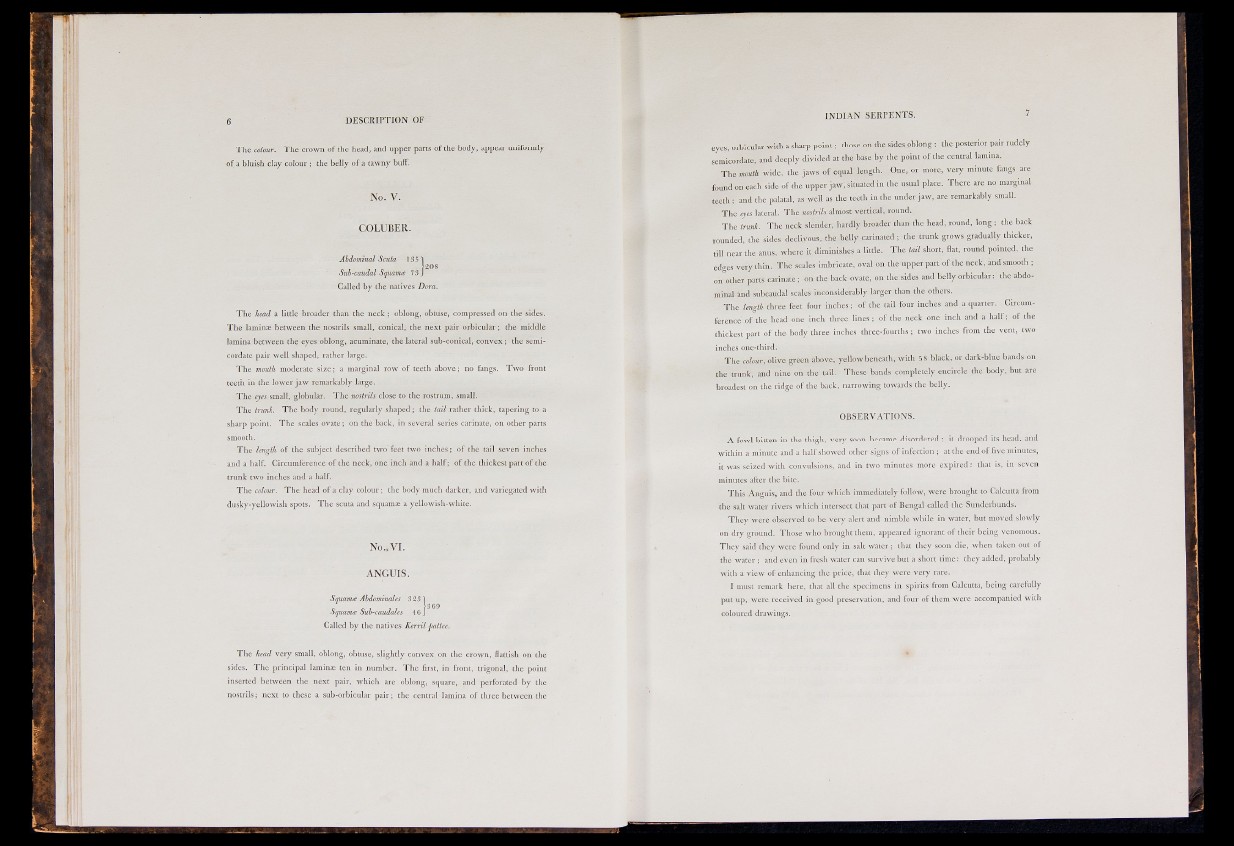
6 DE S C R I P T I ON OF
The colour. The crown of the head, and upper parts of the body, appear uniformly
of a bluish clay colour ; the belly of a tawny bulT.
No. V.
COLUBER.
Abdominal Scuta 13 51
208
Sul-caudal Squamre 73 J
Called by the natives Dora.
The head a little broader than the neck ; oblong, obtuse, compressed on the sides.
The laminae between the nostrils small, conical, the next pair orbicular; the middle
lamina between the eyes oblong, acuminate, the lateral sub-conical, convex; the semicordate
pair well shaped, rather large.
The vioidh moderate size; a marginal row of teeth above; no fangs. Two front
teeth in the lower jaw remarkably large.
The eye.': small, globular. The nostrils close to the rostrum, small.
The irunl. The body round, regularly shaped; the tail rather thick, tapering to a
sharp point. The scales ovate; on the back, in several series carinate, on other parts
smooth.
The length of the subject described two feet two inches; of the tail seven inches
and a half. Circumference of the neck, one inch and a half; of the thickest part of the
trunk two inches and a half
The colour. The head of a clay colour; the body much darker, and variegated with
dusky-yellowish spots. The scuta and squamas a yellowish-white.
No., VI.
ANGUIS.
Squama Abdominales 323
Squama Sub-caudales 46 J
Called by the natives Kerril pattee.
The head very small, oblong, obtuse, slightly convex on the crown, flatfish on the
sides. The principal laminae ten in number. The first, in front, trigonal, the ¡joint
inserted between the next pair, which are oblong, square, and perforated by the
nostrils; next to these a sub-orbicular pair; the central lamina of three between the
INDIAN SERPENTS. ^
eyes, orbicular with a sharp point ; those on the sides oblong ; the posterior pair rudely
semicordate, and deeply divided at the base by the point of the central lamina.
The mouth wide, the jaws of equal length. One, or more, very minute fangs are
found on each side of the upper jaw, situated in the usual place. There are no marginal
teeth ; and the palatal, as well as the teeth in the under jaw, are remarkably small.
The eyes lateral. The nostrils almost vertical, round.
The trunk. The neck slender, hardly broader than the head, round, long ; the back
rounded, the sides declivous, the belly carinated ; the trunk grows gradually thicker,
till near the anus, where it diminishes a little. The tail short, flat, round pointed, the
edges very thin. The scales imbricate, oval on the upper part of the neck, and smooth ;
on other parts carinate; on the back ovate, on the sides and belly orbicular: the abdominal
and subcaudal scales inconsiderably larger than the others.
The length three feet four inches; of the tail four inches and a quarter. Circumference
of the head one inch three lines ; of the neck one inch and a half; of the
thickest part of the. body three inches three-fourths ; two inches from the vent, two
inches one-third.
The colour, olive green above, yellow beneath, with 5 8 black, or dark-blue bands on
the trunk, and nine on the tall. These bands completely encircle the body, but are
broadest on the ridge of the back, narrowing towards the belly.
OBSERVATIONS.
A fowl bitten in the thigh, very soon became disordered ; it drooped its head, and
within a minute and a half showed other signs of infection ; at the end of five minutes,
it was seized with convulsions, and in two minutes more expired; that is, in seven
minutes after the bite.
This Anguis, and the four which immediately follow, were brought to Calcutta from
the salt water rivers which intersect that part of Bengal called the Sunderbunds.
They were observed to be very alert and nimble while in water, but moved,slowly
on dry ground. Those who brought them, appeared ignorant of their being venomous.
They said they were found only in salt water ; that they soon die, when taken out of
the water ; and even in fresh water can survive but a short time: they added, probably
with a view of enhancing the price, that they were very rare.
1 must remark here, that all the specimens in spirits from Calcutta, being carefully
put up, \vere received in good preservation, and four of them were accompanied with
coloured drawings.